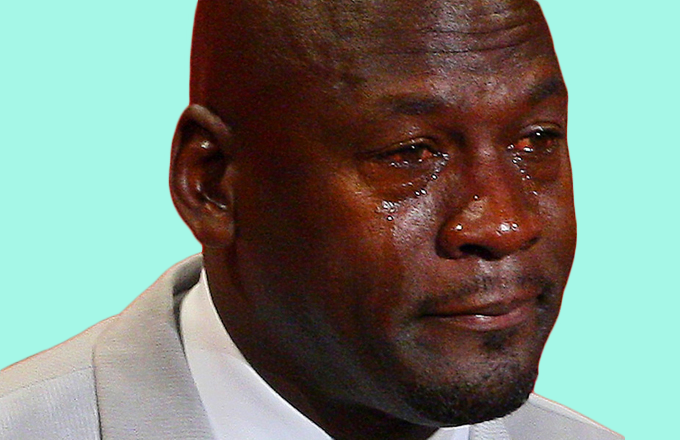By this point everyone has seen the picture of Michael Jordan crying at his Hall of Fame induction, as it is being used on memes everywhere. Can use of this photo in a meme get you sued?
Copyright law grants exclusive rights of an original work to its creator, in this case the Associated Press. Of course there are exceptions that allow for use without permission from the copyright holder. We are going to evaluate if use of the Michael Jordan’s crying face in a meme constitutes as fair use, thus making it not subject to copyright laws.
To determine if use of a work is considered “fair use,” there is a four-part test that a court will implement. First, a court will look at the purpose and character of the original work. If the work is being used in a transformative, not for profit, educational, or personal way, then it favors fair use. If the work is used in a commercial, entertainment, or for profit way, then it favors the copyright owner and will require permission to use. Strong factors that weigh in favor of fair use are for criticism, commentary, and news reporting. Applying this the use of Michael Jordan’s crying face in a meme seems to fall between personal use and entertainment, but these memes are often transformative in context, tipping the first test in favor of fair use.
In the second test, a court will analyze the nature of the work. After the original work is published, the court does not protect the work as tightly. When the original work is unpublished, a court will enforce the copyright to ensure the creator has the right to first publish. The crying Michael Jordan face came from a published photo, thus favoring fair use.
The third factor looks at the amount of work used. If the amount of work being used is large or the heart of the original work, then a court is likely to protect it under copyright laws and would require permission to use. If the work being used is only a small amount or not the heart of the original work, a court is more likely to favor fair use. The crying Michael Jordan face seems to be the heart of the original work because the original picture is largely circulated based on Michael Jordan crying, not because he is speaking at his Hall of Fame induction. For this reason the third factor weighs in favor of requiring permission to use.
The fourth and final factor a court will weigh is the market effect on the original work. A court will look at if the original work is being harmed in any way by the use of the meme. A court is likely to say that the use of the meme does not interfere with the market that the original work is targeted at.
After applying the four factor test for fair use, it seems clear that the crying face of Michael Jordan falls within fair use. However, if the crying face was ever to be used in a profitable way, it could change multiple factors of the four step test and sway a court in favor of protecting the copyright, which would then force user to receive permission from the Associated Press.
Michael Jordan may also have a Right of Publicity claim against those using his image. Right of publicity and misappropriation claims arise from use of ones likeness or persona for commercial purposes. The elements that fulfill a right of publicity claim are: (1) Use of someone’s name, identity, likeness, or persona; (2) through use the defendant achieved a commercial advantage; (3) the use was made without the person’s consent; (4) there is injury to the plaintiff.
The use of Michael Jordan is not in question, fulfilling the first element for a claim against right of publicity. The second element depends on if the potential defendant used the image to gain a commercial advantage. If the defendant used the image in a profitable way it would constitute a commercial advantage and fulfill the second element. The third element is fulfilled if the defendant did not receive permission from Michael Jordan to create the meme. Finally, the fourth element would be injury to Michael Jordan. Michael Jordan would be able to show injury in the form of public perception or lost income.
A successful right of publicity claim by Michael Jordan will largely depend on if the use by a defendant constituted a commercial advantage. As long as the meme is not being used for a commercial purpose, Michael Jordan does not have a strong claim for a right of publicity violation.
Neither the Associated Press nor Michael Jordan currently have strong claims against those creating the memes. However, if someone were to use the meme in an advertisement, he/she can expect to be hearing from both the Associated Press and Michael Jordan’s lawyers.

